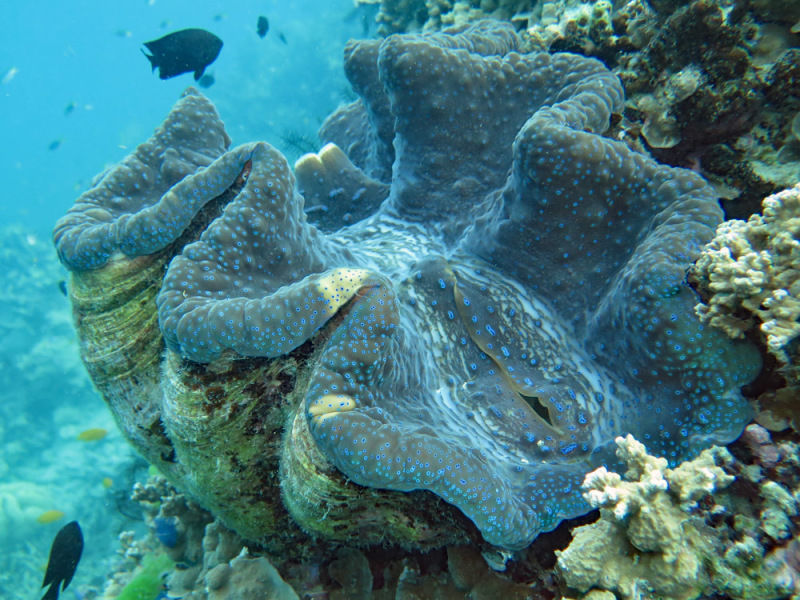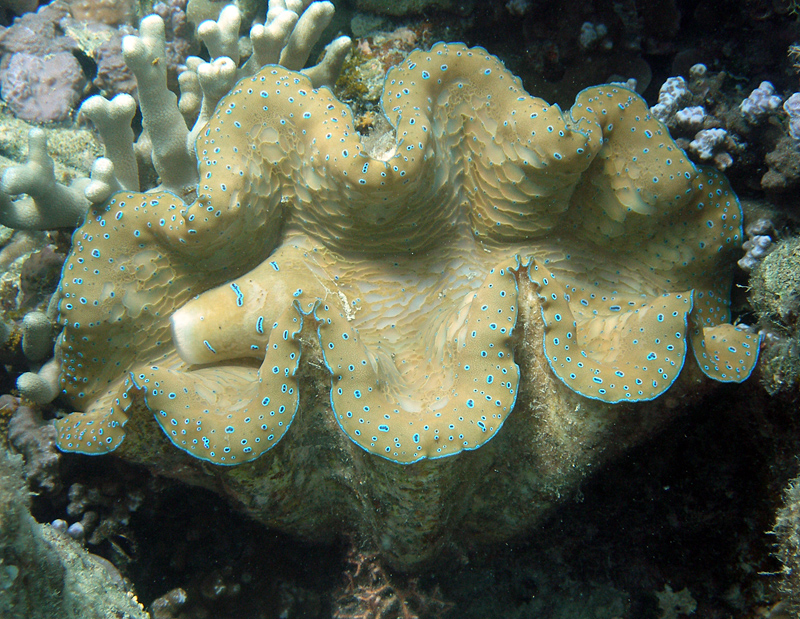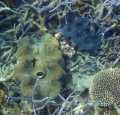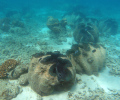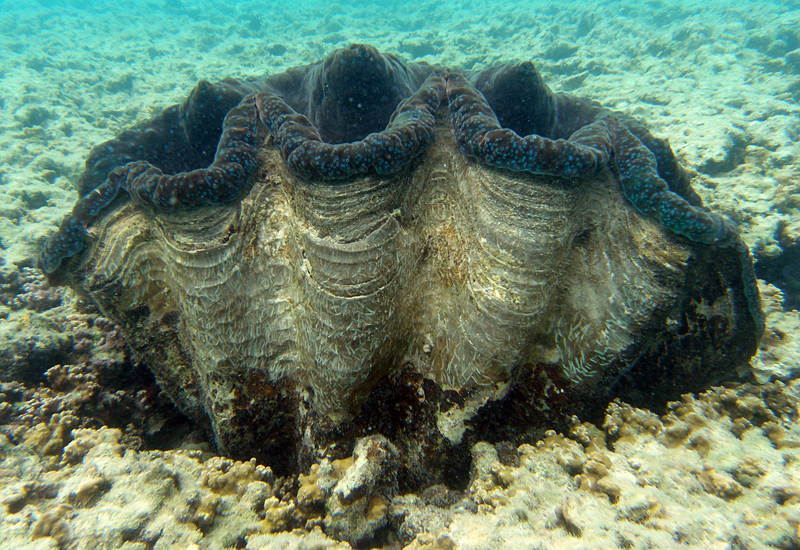
©Andy Lewis: An adult Tridacna gigas at Watson's Bay, showing the growth steps in the shell typical of clams less than 25 years old
Distinguishing features
The largest species of Giant Clam, and the largest bivalve ever to have existed in the fossil record. This species has symmetrical shell valves and no scutes, however the shell is strongly convoluted into a series of 5-6 ridges and valleys. The animal is attached to the benthos by the byssal threads when small, however it does not embed in the substratum like T. crocea and T. maxima. Large specimens are not attached. Mantle colour is somewhat variable, although not to the same extent as the smaller species of Tridacna. Numerous small ocelli are found all over the mantle, and the mantle may be either all dark brown, all light brown, or a mixture of dark and light brown blotches. However this may be due to different strains of zooxanthellae, as colour has been observed to change in captive situations (R.D. Braley, pers. comm). The mantle extends over the edge of the shell when fully extended. Distinguish from other species of Tridacna by the size, the smooth shell and ocelli on the mantle.
Size
- Up to 135 cm (Length of specimen)
Synonyms
Distribution
Distribution and habitat preferences
Found in most habitats, but most abundant in shallow, sheltered lagoonal and reef flat habitats.
Found in most shallow habitats around Lizard Island, and extends down to about 6-7m.
Behaviour
Like other Tridacnid clams, this species is a hermaphrodite, with the male testes forming first between 5 and 9 years of age, followed by the female ovaries at 15-19 years old. Tridacnid clams spawn in the warm summer months between October and February, usually during neap tides when water movement is minimal. This allows enough time for adequate mixing of the gametes. Spermatozoa are usually released first, with eggs only released if the animal detects the presence of sperm from a conspecific clam in the water column. Hence, reproduction is most successful when the animals are located in natural clusters. Eggs are only 100µ��������������������m (1/10th of a mm) in diameter, and several million are released by each clam during a spawning event. Fertilisation is external, and a trochophore larvae hatches after about 12 hours. A bivalved veliger larvae develops after 48 hours, with a shell length of 160µ��������������������m, which is followed by a pediveliger with a basic foot and velum. This stage feeds on plankton and continues to swim in the water column, although it periodically ventures down to assess the conditions on the benthos. The pediveliger larvae settle permanently to the substratum at about 9 days of age and about 220-240µ�������������������m, and the juvenile clams may reach 20-40mm shell length after their first year. Growth accelerates after this point, however mortality in the first few years is very high, with predation by fishes and crabs being a major factor.
Adult Tridacnid clams obtain over 95% of their food requirements from the sugars produced by the symbiotic dinoflagellate algae (zooxanthellae) that inhabit the outer mantle tissue, however filter feeding is still important in the newly settled juveniles. Clams acquire the zooxanthellae directly from the water column at the time of settlement, and the algae live in tubules that are tertiary extensions of the gut and extend throughout the mantle tissue. Like hard corals, Tridacnid clams may bleach and lose most of their zooxanthellae after high temperature stress. Recent research shows that tridacnid clams may have several different strains of symbionts present simultaneously in the mantle tissue, a situation not generally seen in hermatypic hard corals.
Tridacna gigas have been studied at Lizard Island for more than 25 years, both in terms of reproductive ecology and population dynamics. The population density in some places (e.g. Watson's Bay, ≈200 clams/ha ) is amongst the highest recorded anywhere in the world. There was a widespread mortality event at Lizard Island between winter 1985 and summer 1986-87 which resulted in mortality of about 50% of the adult clam population. Interestingly, in the summer of 1985-86, there was a large juvenile recruitment event of T. gigas (and to a lesser extent T. derasa) at Lizard Island, with settlement densities in the order of 60-155 juvenile clams per hectare. This cohort of animals is now mature at 85-95cm shell length and comprise the majority of specimens at most locations around the Island. They can be identified by their relatively clean shells with obvious growth bands (see main image above). Older specimens are still present in the population, however these animals have obvious bioerosion of the shell (see additional images).
At Lizard Island, T. gigas is often attended by the Black Damselfish (Neoglyphidodon melas), which consumes the fecal pellets released from the clam about every 5-10min throughout the day. When clams are surrounded by areas of hard coral cover, 1-2 fish usually remain resident near the clam, however fishes do not usually associate with clams found in open areas without shelter corals nearby. Territorial farming damselfish (Stegastes nigricans) occasionally incorporate the giant clams into their algal farms, and bite the mantle tissue, causing damage but rarely causing the death of the clam.
T. gigas have been reared throughout the whole life-cyle in a culture situation, and large numbers of these clams have been produced in mariculture facilities in Australia and other Indo-Pacific locations over the last 20 years. There has been a limited amount of restocking of clams onto over-fished reefs, however large scale commercial aquaculture of this species is still yet to take place, despite a strong demand for clam meat in SE Asia.
Web resources
References
- Alder, J. and R. Braley (1989). Serious mortality in populations of giant clams on reefs surrounding Lizard Island, Great Barrier Reef, Australian Journal of Marine and Freshwater Research, 40: 205-213. LIRS catalog number 262.
- Belda-Baillie, C.A., M. Sisona, V. Silvestrea, K. Villamora, V. Monjea, E.D. Gomez and B.K. Baillie (1999). Evidence for changing symbiotic algae in juvenile tridacnids, Journal of Experimental Marine Biology and Ecology, 241: 207-221.
- Braley, R.D. (1984). Reproduction in the giant clams Tridacna gigas and T. derasa in situ on the north-central Great Barrier Reef, Australia, and Papua New Guinea, Coral Reefs, 3: 221-227. LIRS catalog number 135.
- View all references
